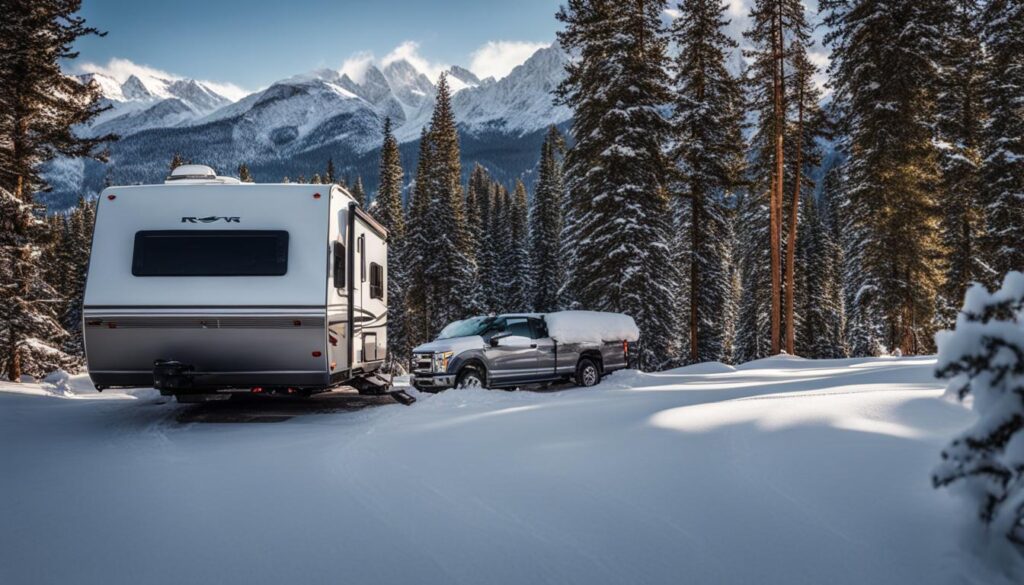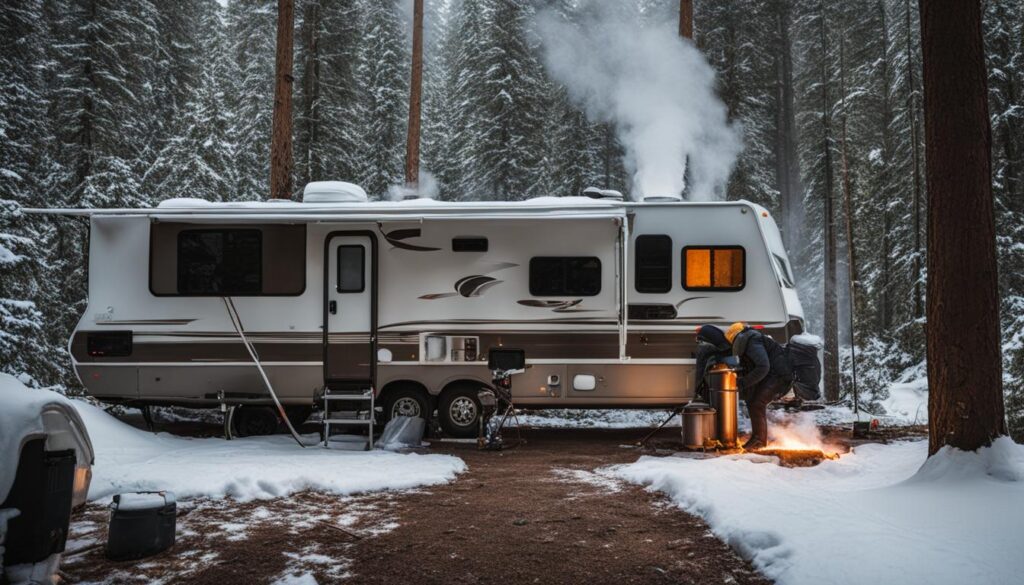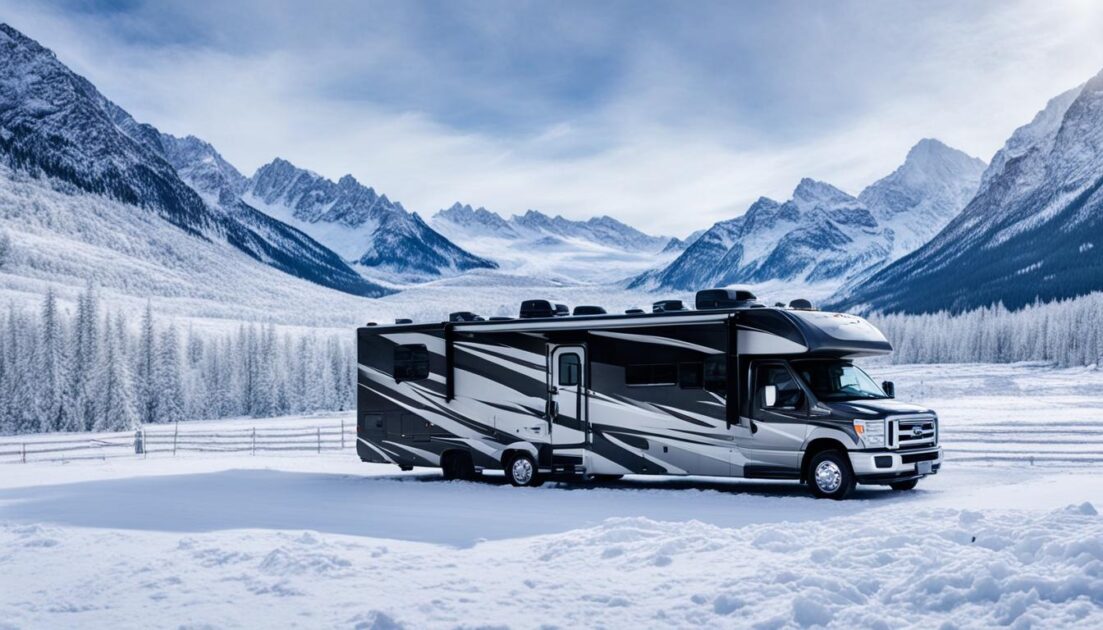When going on a winter camping trip in your RV, it’s important to take precautions to prevent your pipes from freezing. Frozen RV pipes can cause a range of problems, from stopping the flow of fresh water to causing flooding and major damage to your RV. To avoid these issues, there are several methods you can use to keep your RV pipes from freezing.
Key Takeaways:
- Insulate your RV pipes using closed cell spray foam insulation or pipe insulation kits.
- Empty your waste tanks to remove the possibility of water freezing.
- Consider professional insulation or DIY methods to insulate the rest of your RV.
- Keep the interior of your RV warm by using heaters strategically and employing a tank heating pad.
- Utilize RV skirting to trap heat and keep pipes warm.
Methods to Keep RV Pipes from Freezing
When it comes to winterizing your RV and preventing frozen pipes, there are several effective methods you can employ. The key is to insulate your RV pipes and take necessary precautions to protect them from the cold weather.
Insulate Your Pipes
One of the most important steps you can take to prevent frozen RV pipes is proper insulation. Insulating your pipes helps to keep the water inside them from freezing, ensuring a steady flow of water during your winter camping trips. You have two options for insulating your pipes:
- Closed Cell Spray Foam Insulation: Applying closed cell spray foam insulation directly to your pipes creates a protective barrier that prevents heat loss and minimizes the risk of freezing. This type of insulation is easy to apply and provides excellent insulation properties.
- Pipe Insulation Kits: Pipe insulation kits are another effective solution for insulating your RV pipes. These kits include foam sleeves or wraps that you can easily install to provide insulation and prevent freezing. They are readily available and simple to install, making them a popular choice among RV owners.
By insulating your pipes, you significantly reduce the chances of frost damage and ensure a reliable water supply throughout your winter camping adventures.
Insulate the Rest of Your RV
While insulating your pipes is crucial, it’s also important to insulate the rest of your RV to maintain a warm and comfortable interior. To protect your pipes from freezing, consider the following insulation options:
- Door and Window Insulation Kits: These kits provide insulation for doors and windows, minimizing heat loss and improving energy efficiency. They are easy to install and help to keep your RV’s interior warm.
- Tank Heating Pad: Using a tank heating pad is an effective way to keep your water tanks from freezing. These pads provide gentle heat to prevent water from solidifying in extremely cold temperatures.
By insulating the rest of your RV, you create a cozy environment while safeguarding your pipes against freezing.
Additional Tips
In addition to insulation, there are a few more tips to help you avoid frozen RV pipes:
“Emptying your waste tanks regularly is essential to prevent any water in them from freezing and causing blockages or damage.”
- Empty Waste Tanks: Emptying your waste tanks regularly is essential to prevent any water in them from freezing and causing blockages or damage.
- Heat the RV’s Interior: Keeping the interior of your RV warm is crucial for preventing frozen pipes. Use portable electric heaters or the RV’s built-in heating system to maintain a comfortable temperature.
- Install RV Skirting: RV skirting involves wrapping a barrier around the bottom of your RV, creating an insulation layer. This can help trap heat and prevent cold air from entering, further safeguarding your pipes.
By following these methods and tips, you can enjoy worry-free winter camping without the fear of frozen RV pipes.

| Method | Description |
|---|---|
| Insulate Your Pipes | Use closed cell spray foam insulation or pipe insulation kits to protect your RV pipes from freezing. |
| Insulate the Rest of Your RV | Install door and window insulation kits and use a tank heating pad to keep your RV’s interior warm and prevent freezing. |
| Additional Tips | Empty waste tanks regularly, heat the RV’s interior, and install RV skirting to further prevent frozen pipes. |
Dump Your RV Waste and Insulate Your Pipes
One of the first steps to protect your RV plumbing system in cold weather is to empty out your waste tanks. This eliminates the risk of water freezing in the tanks and causing damage. Additionally, it’s crucial to properly insulate your pipes, with a particular focus on insulating the fresh water tank.
Dumping Your RV Waste
Emptying your waste tanks is an important step in winterizing your RV. To do this, follow these simple steps:
- Locate the dump station at your campsite or a nearby RV dump station.
- Connect your RV’s sewer hose to the dump station’s receptacle.
- Open the black water tank valve to release the waste contents into the dump station.
- Once the black water tank is emptied, open the gray water tank valve to drain the remaining wastewater.
- After emptying both tanks, close the valves and disconnect the sewer hose from the dump station.
- Properly stow and secure the sewer hose in its designated compartment.
By following these steps, you’ll ensure that your waste tanks are empty, reducing the risk of freezing water and potential damage to your RV.
Insulating Your Pipes
Insulating your RV pipes is crucial for preventing freezing in cold weather. There are two effective options for insulating your pipes:
- Professional insulation: Hiring a professional to insulate your RV’s plumbing system with closed-cell spray foam insulation is an excellent option. This method provides comprehensive and durable insulation, protecting your pipes from freezing temperatures.
- DIY pipe insulation kits: If you prefer a more hands-on approach, you can use a DIY pipe insulation kit. These kits typically include foam insulation tubes that can be easily cut to fit your pipes. Simply slide the insulation over the pipes, ensuring a snug fit, to provide an additional layer of protection against the cold.
Remember to prioritize insulating your fresh water tank, as this is where your RV’s water supply is stored. By insulating the tank, you’ll help maintain the temperature of the water and reduce the risk of freezing.
For a visual representation of how to empty your waste tanks and insulate your pipes, refer to the following table:
| Dumping Your RV Waste | Insulating Your Pipes | |
|---|---|---|
| Step 1 | Locate the dump station | Choose professional insulation or DIY kit |
| Step 2 | Connect sewer hose to dump station | Focus on insulating fresh water tank |
| Step 3 | Open black water tank valve | Insulate other pipes in the RV |
| Step 4 | Open gray water tank valve | |
| Step 5 | Close valves and disconnect sewer hose | |
| Step 6 | Stow and secure sewer hose |
By following these steps and insulating your pipes, you’ll take important measures to protect your RV plumbing system in cold weather. This will help ensure a trouble-free winter camping experience, allowing you to enjoy your RV to the fullest.

Insulate the Rest of Your RV and Use Heating Methods
In addition to insulating your pipes, it is essential to insulate the rest of your RV to prevent freezing during cold weather. By taking these extra steps, you can ensure the overall warmth and protection of your RV’s plumbing system. Here are some best practices for preventing RV pipe freeze:
Insulation
To prevent the cold air from seeping into your RV, consider insulating your doors and windows. This can be easily done using door and window insulation kits readily available in the market. Alternatively, you can hire a professional to install insulation for optimal results.
Interior Heating
Keeping the interior of your RV warm is crucial for preventing frozen pipes. Strategically placing electric heaters throughout your RV can help maintain a consistent temperature, ensuring that the pipes remain above freezing levels. Additionally, using a tank heating pad can provide an extra layer of protection for your water storage system.
RV Skirting
Installing RV skirting is another effective method to trap heat and keep your pipes warm. RV skirting creates an insulated barrier around the bottom of your RV, preventing cold air from penetrating and freezing the pipes. This protective layer not only helps maintain a comfortable temperature inside the RV but also adds an extra layer of defense against freezing temperatures.

| Benefits of Insulating Your RV | Benefits of Interior Heating | Benefits of RV Skirting |
|---|---|---|
| Prevents heat loss through doors and windows | Maintains a consistently warm temperature inside the RV | Traps heat and prevents cold air from entering the RV |
| Reduces the risk of frozen pipes | Protects the plumbing system from freezing | Provides an additional layer of insulation |
| Improves energy efficiency | Prevents damage to pipes and plumbing fixtures | Saves on heating costs |
By insulating the rest of your RV and implementing effective heating methods, you can significantly reduce the risk of frozen pipes during your winter camping adventures. These best practices will help ensure that your RV’s plumbing system remains functional and protected, allowing you to enjoy a worry-free camping experience.
Other Tips for Preventing Frozen RV Pipes
When it comes to preventing frozen RV pipes, there are a few additional tips that can help you avoid potential issues. First, keeping the lights on inside your RV can provide a source of heat and help maintain a warmer temperature. Additionally, choosing a sunny campsite can naturally warm up the surroundings and provide some insulation for your pipes.
Another important tip is to avoid leaving your sewer hose connected or open. This can expose your pipes to extremely cold temperatures and increase the risk of freezing. Instead, consider using your tanks instead of hookups whenever possible. This allows you to have more control over the temperature and avoid potential freezing hazards.
It’s crucial to be aware of the signs of frozen pipes and take immediate action if you suspect any freezing. Look out for reduced water flow or complete water loss, unusual noises coming from your pipes, or a frosty exterior on exposed pipes. If you notice any of these signs, it’s important to act quickly to prevent further damage.
Having a backup water pump and a heat gun or compact hair dryer can be valuable tools in case of a frozen pipe. These devices can help thaw out frozen pipes and restore water flow. However, it’s recommended to use them with caution and follow proper safety guidelines to avoid any accidents or damage to your RV.
FAQ
How can I prevent my RV pipes from freezing while camping in winter?
To prevent your RV pipes from freezing while camping in winter, there are several methods you can use. Insulating your pipes with closed cell spray foam insulation or pipe insulation kits is one effective method. Insulating the rest of your RV and using a tank heating pad can also help protect your pipes from freezing. Other tips include emptying your waste tanks, heating the RV’s interior, and installing RV skirting.
How do I insulate my RV pipes to prevent freezing?
Insulating your RV pipes is crucial to prevent freezing. You can insulate your pipes with closed cell spray foam insulation or pipe insulation kits. Pay particular attention to insulating the fresh water tank. These insulation methods will help keep your pipes warm and prevent freezing during winter camping.
How can I protect my RV plumbing system in cold weather?
To protect your RV plumbing system in cold weather, there are a few steps you can take. Firstly, make sure to empty out your waste tanks to prevent any water from freezing. Secondly, insulate your pipes with spray foam insulation or pipe insulation kits. Additionally, insulating the rest of your RV, heating the interior, and installing RV skirting can all help keep your pipes from freezing.
What are the best practices for preventing RV pipe freeze?
The best practices for preventing RV pipe freeze include insulating your pipes and the rest of your RV, using heating methods such as electric heaters and tank heating pads, and emptying your waste tanks. It is also helpful to keep the interior of your RV warm by keeping the lights on and choosing a sunny campsite. Avoid leaving your sewer hose connected or open, and use your tanks instead of hookups whenever possible.
Are there any other tips for preventing frozen pipes in an RV?
Yes, there are other tips for preventing frozen pipes in an RV. Some additional tips include knowing the signs of frozen pipes and taking immediate action if you suspect freezing. It can also be helpful to have a backup water pump and tools like a heat gun or compact hair dryer on hand in case of a frozen pipe.

